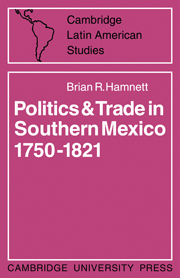Book contents
- Frontmatter
- Contents
- Acknowledgments
- Archival abbreviations
- Weights, measures, and currency
- Introduction
- 1 Oaxaca—environment and trade
- 2 The struggle for control of trade
- 3 The problem of reform, 1768–1786
- 4 Reform and reality—the crisis of the subdelegations in the 1790s
- 5 The Gálvez Plan under fire, 1786–1804
- 6 Finance, trade, and the merchants, 1789–1808
- 7 The political crisis of 1808–1821
- 8 Conclusion—Oaxaca within the context of Mexican politics
- Glossary of Personnel
- Appendices
- Sources and bibliography
- Maps
- Index
8 - Conclusion—Oaxaca within the context of Mexican politics
Published online by Cambridge University Press: 04 August 2010
- Frontmatter
- Contents
- Acknowledgments
- Archival abbreviations
- Weights, measures, and currency
- Introduction
- 1 Oaxaca—environment and trade
- 2 The struggle for control of trade
- 3 The problem of reform, 1768–1786
- 4 Reform and reality—the crisis of the subdelegations in the 1790s
- 5 The Gálvez Plan under fire, 1786–1804
- 6 Finance, trade, and the merchants, 1789–1808
- 7 The political crisis of 1808–1821
- 8 Conclusion—Oaxaca within the context of Mexican politics
- Glossary of Personnel
- Appendices
- Sources and bibliography
- Maps
- Index
Summary
Until the political changes of 1810–21 ensured the triumph of the Creoles, the province of Oaxaca had traditionally been dominated by a small group of Spanish Peninsular merchants. For the most part, they undertook mutual financial obligations, and had close contacts with the merchants of the Mexico City Consulado. They were represented on the Ayuntamiento of Oaxaca, a closed body which left most of the work of governing the province to the Royal and episcopal authorities, where they held both elective and hereditary or purchased offices. They farmed many of the principal revenues of both Church and State, were owners or lessees of landed property, particularly in the fertile regions of the Valley of Oaxaca and Teposcolula. Many of them were commissioned officers in the Provincial Militia, established in the 1760s, and enjoyed the juridical privilege of the fuero militar under the Ordinance of 1768.
The local merchants and those of the Consulado of Mexico were particularly interested in Oaxaca's scarlet dye, extensively produced only by the Indian population, and in great demand in the textile factories of France, Holland, Britain, and Spain. The merchants traded with the great Spanish merchant houses, the Casa de Uztáriz and the Cinco Gremios Mayores de Madrid and others.
The insolvency of the Spanish régime, and its failure to pay its local administrators, the Alcaldes Mayores, a proper salary ensured that they would fall into the financial power of the merchants.
- Type
- Chapter
- Information
- Politics and Trade in Mexico 1750–1821 , pp. 148 - 155Publisher: Cambridge University PressPrint publication year: 1971



